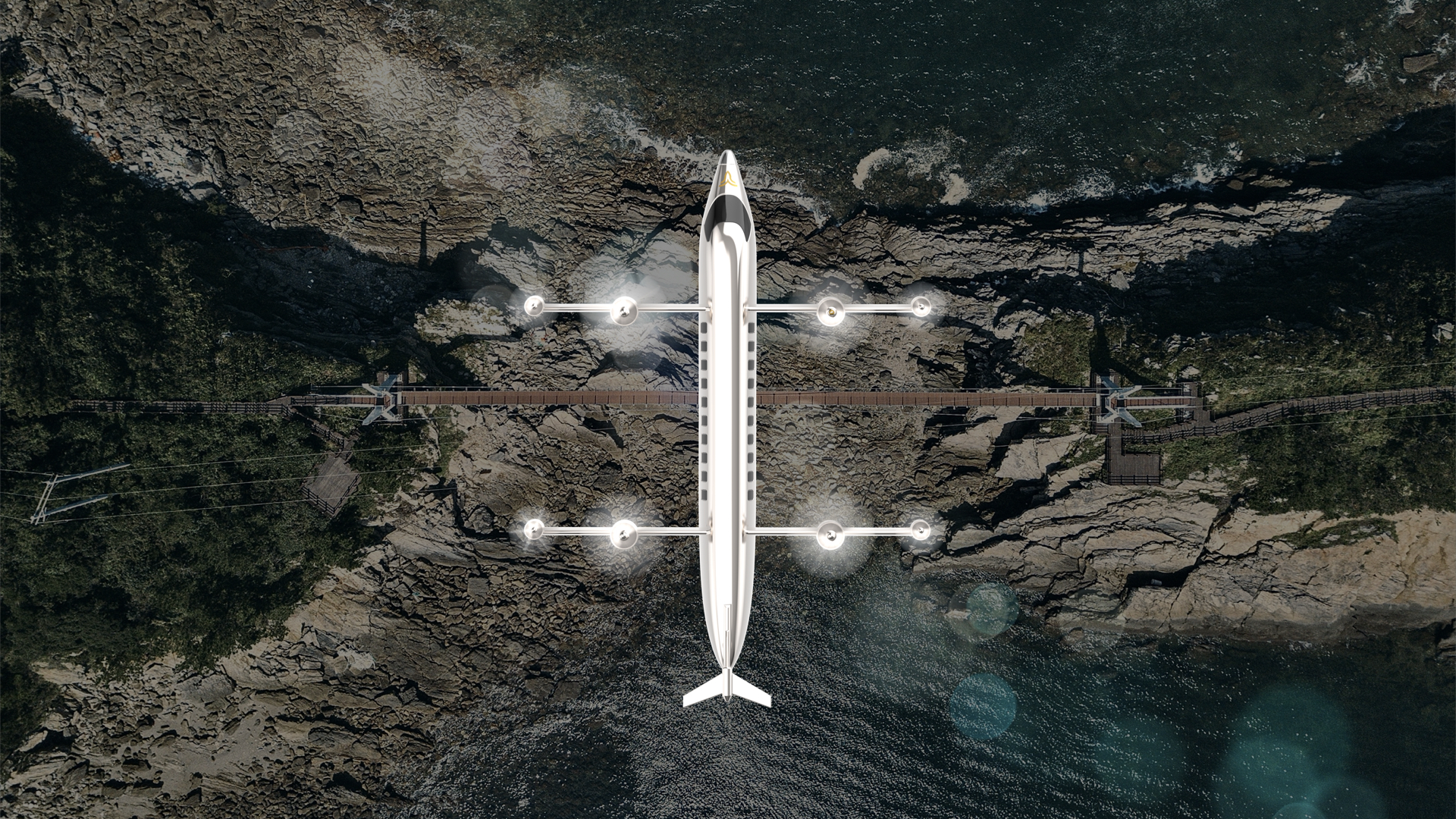What does LYTE mean? What’s the story behind the LYTE & LA-44 designation?
“My life completely changed after a stroke of fate summer 2019, which gave me then full certainty and confidence that whatever I decide to create from now on, will have a huge impact for the wellbeing of our planet and the abundant mobility of human beings and goods and increase connectivity globally even further. The light is showing me the path, and has manifested so many wonderful people to collaborate with me on this journey. Today, we can speak about that “light” as many very successful people are starting their days with meditation and in alignment because that creates an absolutely different access to ideas and creativity throughout the day.” responded CEO & Founder LYTE – Freshta Farzam
But simultaneously, “lyte” sounds like “light and ease“, even though we are focusing on heavyweight eVTOL. We approach this challenge from a holistic view and are eager to find continuously easy and feasible solutions. And we have created a relatively feasible aircraft that will disrupt and redefine regional aviation as we know it today, and prevent hopefully forests from being eradicated for ground infrastructure in the future, as with flying trucks you will be able to deliver goods more frequently and much faster than trucks or trains one day. In 1973 Marty Cooper invented the first mobile phone and no one would have thought it would be in every human being’s pocket 40 years later. And I definitely want to live to see the flying trucks becoming the new normal for good deliveries in the future. LA 44, LYTE Aviation the SkyBus variant can take up to 40 passengers, and 2 seats for pilots (if required) and 2 crew members (if required), depending on the future regulations for UAM.
The LA-44 is a tiltwing with four conventional turboprops and four electric motors, the latter for pitch and lateral control at slow speeds and in vertical flight. How will you overcome the challenges faced by previous tilt-wings, including vibration, weight, noise and mechanical complexity/poor reliability?
Vibration: the level of vibration will be just comparable with a regional turboprop and expectably lower than a small 4-seat eVTOL, while definitely much lower than an helicopter, so it doesn’t appear as a big deal for the SkyBus passenger version; even less of an issue for the cargo SkyTruck
Weight: It will be only marginally higher than a regional aircraft of comparable capacities and performances, due to the propulsion system and fuel required for vertical takeoff. Hardly a killer when compared with the advantage offered in terms of VTOL operations. If instead we compare the LA44 to an helicopter of similar capacities, we’re clearly needing about 1/5 of the fuel for same payload and range greatly saving on the total weight
Noise: This not our prior concern for the SkyTruck cargo variant that will fly in remote areas far from civilization anyway. But of course, for the SkyBus version, we have a few iterations in design, e.g. taking off/landing and cruising eventually with only 4 props with our patented solution. . So, there are ways to work on noise reduction, also for conventional combustion engines until we hopefully soon can shift completely to hydrogen-electric and take off with much more silent electric engines. There are always ways to solve a problem but we have to start solving the main problems first: exponentially growing world population and thus, growing good delivery demand in the next decades, highly congested roads especially in megacities, even in developed countries like California, you get struck for almost 1.5-2 h driving from OC to LA, imagine by SkyBus you could move 40 pax within 20min, and how much the entire ecosystem around our concept will benefit from it. Even more jobs from maintenance to newly required job descriptions for our SkyBus / SkyTruck.
Mechanical complexity: compared to a helicopter we are way less complex in production and also in maintenance. It’s also less complex than a tilt rotor like the V-22 and AW-609, as in these aircrafts, the two rotors need extremely complex and sophisticated transmissions as they need not only to lift the aircraft during vertical maneuvers but also provide all the capability of balance and control which are typical of the helicopter as well as the propulsion during the horizontal phases of the flight. We get away from all this thanks to an inherently stable 4 propulsion and tandem wing system.
Poor reliability: Regarding what? When we have 2 tandem tilt wings with a solid structure in the fuselage, conventional turboprops that are being used today in many aircrafts and electric engines that are being used by air taxis and some of them actually take off and get their certifications soon, which part of it would be unreliable? It appears in any case less complicated and more reliable than any sort of tilt-rotor architecture.
A lost engine can be catastrophic in vertical flight because of the instantaneous thrust. Are the LA-44’s engines geared so that one engine powers two propellers in an emergency? And the same for the electric motors?
Absolutely yes, it’s obvious
You’ve already announced two partnerships. I’m guessing that as a developer you don’t intend to build the aircraft yourselves. When do you anticipate announcing airframe, engine, motor, propeller, hydrogen fuel cell and avionics partnerships?
Soon enough. Conversations are taking place with strategic partners in all the areas you mentioned with particular emphasis on the propulsion system.
I assume the primary structure will be composite?
Not fully as metal alloys are still preferred for parts such as the wing main spars and torsion box
You’ve announced Inmarsat as a partner, but its involvement seems to relate to flying the LA-44 as a UAV. Can you explain more about its role and your intentions regarding crewed/uncrewed operation?
We are considering the possibility to operate an uncrewed cargo version in the future, but Inmarsat is also especially a strong sat/com partner for our main target markets, remote areas / offshore etc and they come with the tech expertise in specific countries that we are approaching with a joint vision our potential customers.
Inflight Canada will assist with the Skytruck cargo variant. Does that mean it is helping you optimise the LA-44 for cargo operations, or will it take green airframes and modify them?
Yes, they will help us simplify the conversion from pax to cargo, as we might have use cases where we need to switch faster from pax to cargo (see covid) and they will help us to lay the infrastructure for optimal space usage for cargo transport from scratch on.
Will you keep the SkyTruck name? It is already associated with the PZL M28 Skytruck, a Polish development of the Ukrainian/Soviet Antonov An-28
We can call it also flying truck, but the main message is that we expand our horizons collectively and imagine a world in 50 years where SkyTrucks and SkyBusses are the new normal.
How will you manage the test and certification process? Are you likely to contract a specialist organisation or look to your airframe partner?
Both solutions have advantages and disadvantages.
Assuming that uncrewed operation is on the horizon, how do you envisage achieving passenger safety with no crew?
“As a pilot student and a passionate passenger of planes, I definitely know that a human pilot has of course its advantages, especially from a psychological point of view for passenger mental safety and comfort.” said Freshta Farzam (CEO&Founder LYTE)
However, autonomous flight technology is developing at a steady and fast pace. Uncrewed cargo drones with increasing levels of flight autonomy are ready for service! Many of the present eVTOLs designed for carrying human passengers are also developed to fly uncrewed, which let’s be clear, doesn’t mean completely autonomously.
We can look maybe at the current autonomous cars and their developments. Some of them, like Tesla are giving passengers enough safety to let go of control of the steering wheel. And it works. But that had to be proven and tested first by actual customers, so the confidence was established. Once this becomes the new normal on the ground transportation, where gravity takes care of the weight, then i think passengers will be ready to embrace as a next step passenger safety in flying objects, like air taxis or sky busses…that will become the new normal then. And we believe once the autonomous cars have matured, autonomous aircrafts will then provide enough safety including the navigation and control of gravity in the air.
How will you support the aircraft in service? How would you assist a customer whose LA-44 was AOG after a propeller birdstrike?
An assistance service will be in place as expected for any other established aircraft OEM. Commercial and civilian airplanes of all sizes as well as helicopters incur in this type of accident on a daily basis and manufactures as well as operators have learned way before us to deal with it. We’ll hardly need to reinvent the wheel.
Many companies are working on eVTOL aircraft and there are already many thousands of helicopters in service. But the LA-44 is probably too large for eVTOL infrastructure and significantly different in requirements to a helicopter. How will you install global infrastructure? (The LA-44 has relatively small area ‘propellers’ that will need to turn faster in vertical flight, resulting is powerful downwash that’s likely to preclude it from many established landing sites and require careful preparation for off-airfield landings)
We do not envisage complications dissimilar from what experienced in operations by helicopters and heavy VTOLS. Actually, spreading our vertical thrust on 4 propellers allows us to reduce the thrust delivered by a single rotor by a factor of 2 or 4, hence reducing drastically the effects of downwash and noise.
How will crews and maintenance technicians be trained? Will you nominate a flight simulation partner?
These and many more technical, strategic and operational questions such as this will be tackled as we move from conceptual design to detailed design, prototyping, testing, certification, industrialization, commercialization and each of these open points will be sorted out at the right moment, but yes, we are of course looking at flight simulation partners. Visual simulations are always more inspiring and efficient for all parties involved, crews, technicians but also pilots and for us to sell the best experience for our customers and constantly improve it.
When do you anticipate first flight? What about certification and service entry? Will the LA-44 move cargo first? When? And when will we see it move passengers?
The first flight, which for us is the definition “take off vertically and cruise and land”, would be hopefully within 2 years with our first full-scale prototype. But once we have received our certifications, we will probably be ready to go into serial production after another 3-4 years, probably a similar roadmap as our friends with the air taxis or even faster as we use a lot more existing technologies and are starting with cargo transport in remote areas, which reduces the certification hurdles over urban areas and with passengers.
What missions do you see it adopting beyond regional passenger and freight movement?
- Regional air mobility – bus/train replacement, airport shuttle, airport-airport connection, rural-urban connection.
- Urban air mobility – inside-city connection with a specific fit for MegaCities / B2B company to company
- ideal for replacing helicopters on applications requiring the delivery of goods and equipment in austere and remote locations (e.g. mining and oil industries), offering 5 times lower fuel costs, joined to much higher speed and operational flexibility.
- Emergency rescue/refugee rescue (e.g. war, famine, tsunami, earthquake; bringing food and medical aids, evacuating refugees/survivors, medical transport).
- Transport staff and goods to and from oil rigs and remote locations (e.g.mines, prospection, etc.).
- Military transport (logistics, cargo, troops, medevac, etc.).

